Magical Bolivia
A few hours later we reached the border town of La Quiaca to the tune of more trumpets. It seems like every town has it's own band playing the exact same piece of music. At the border we got stamped out of Argentina and crossed over to join a huge crowd waiting to get into Bolivia. As luck would have it it turned out that the throng were actually waiting to get stamped out of Bolivia so we quickly got processed. Moving our watches back an hour we entered Villazon, the Bolivian border town and immediately sensed we were in a new country. The streets were busy, colourful and the local women were dressed in their traditional frilly full skirts and bowler hats. We had hours to put in before our 3pm bus to Tupiza so we happily sat in the park watching the world go by. At 2pm we decided it might be best to double check that the clocks had definitely gone back an hour. I spotted a well dressed business man marching confidently through the square with a large watch on his forearm. To my horror he announced the correct time was just after three o'clock. We made a mad dash for our bus only to arrive to be told it was only 2pm. Just our luck I managed to pick out the only guy on the Bolivian side of the border with a watch running on Argentinian time. An hour later we finally escaped from Villazon and boarded the bus to Tupiza, almost three hours into the supposedly two hour journey we started to get concerned. We were being thrown around like rag dolls due to the bumps on the unpaved road, we were in the middle a wilderness and it was getting dark and darker. There seemed no way that we'd turn a corner and suddenly enter any kind of a substantial town. Our worries proved unfounded eventually we did turn a corner and arrived in Tupiza a surprising pretty little town. After finding accommodation we set out for some dinner and found The Alamo, a little restaurant filled to the rafters.
The rest of our time in Tupiza was spent trying to find a tour going through the national park and Salar de Uyuni. After a couple of false starts we eventually came across an agency that fitted the bill. We set off with South Africans Dom and Peta and English girl Kelly for our day jeep ride. The "Salar de Uyuni" jeep trip is one of the most worthwhile four days spent in Bolivia.
The salt plains are just one day of it, the other days are spent travelling through very different and diverse scenery, some of the best in Bolivia. Our first day from Tupiza was spent climbing through hills out onto the plateau, stopping for lunch, frisbee throwing with kids in various towns before stopping for the night in a small village. Cards ,namely the game "Benny" was played for hours nightly. The following two days the scenery changed to lagoons of various colours then to flamingo filled lagoons. For some reason as we progressed the flamingos seemed to get less anxious to flee allowing us to get close to them. One of the highlights of the trip was a dip in a thermal pool in the middle of no where - there wasn't a working shower to be seen in the four days so it was probably just as well.
The following day brought smoking volcanoes, steaming geysers and bubbling mud pools.
:: Salt Bricks maketh the Salt Hotel ::
Our final night was spent in a Salt Hotel on the edge of Salar de Uyuni. Some of the group went as far as licking the walls to confirm that it was indeed made of salt. Basically the structure was built from salt bricks, the beds, chairs and steps were all carved out of salt a thick layer of salt served as the floor. Our night's stay there was surprisingly comfortable - although it probably had something to do with the fact that it was the only night on the trip where the temperature did not plummet way below zero (we were sleeping around 4000m previously....v.vhigh & cold). We felt sorry for people coming the other way on day one of their trip.
:: Sunrise over the Salt Flats ::
Our final day was spent on the salt flats of Salar de Uyuni. It's an intense landscape, blindingly white salt as far as the eye can see and blue skies. An island populated by cacti in the centre of the Salar de Uyuni offers a good vantage point to marvel it all. After the boys whiled a couple of hours away playing frisbee it was on to the middle of the plain to take some of the customary silly photos. Early that afternoon we reached Uyuni, a total kip of town that only exists because it serves as the jumping off point for tourists to the Salar de Uyuni. We quickly bought a bus ticket for the following morning not willing to chance being stranded for another day in Uyuni. The next stop in Bolivia was the highest city in the world ,Potosi, once one of the largest cities in the Americas. Climbing up the steep hill into town from the bus station you could really feel the altitude. In colonial times Potosi thrived as a city when the Spanish discovered that it's mountain contained vast quantities of silver. It quickly prospered into the Spanish's main coin minting centre. To this day the mines are still excavated, although largely for nickel as the silver quantities are depleted. The mines have a dark history, it's thought that 8 million people have lost their lives. Many agencies bring tourists down the mines; it's one of the most dangerous, scariest experiences you can ever have. Dee visited them last time she was there, so it was Marcus' turn this time. Lets just say, big guy, small spaces, rickety ladders, dusty, dark and dynamite detonating. Seeing the light of day at the surface after 3 hours down the mines was a relief.
Another worthwhile sight in Potosi is the Mint Museum. It still home to many of the impressively large minting machines that churned out Spanish coins for decades. As with every place in Bolivia, Potosi has lots of marching bands, no shortage of ice-cream vendors and lots of chicken restaurants.
And on to Sucre, it used to be the capital of Bolivia before it was moved to La Paz. Sucre is a beautiful old colonial city with impressive white buildings. We ended up staying in a hotel directly in front of the city's market - an endless source of fresh fruit, shakes, olives, cheap dinners and just about anything else you could want right on our doorstep. It was in Sucre that we experience our worst hailstorm ever. We were caught out in the rain and made it as far as the market, we were a mere metres from the entrance into our accommodation when the rain turned to hail forcing us to take cover. The hailstone were so big that they actually hurt when they hit. The only cover available was canvas umbrellas and covers over vendor's stands. At one stage the hail was coming down so hard that it looked like it might breach the canvas.
Everything in the city came to a standstill as torrents of hail fell and flooded the streets. When it finally stopped we had to make a mad dash for the bus station, the water was so deep in the streets that the shoes and socks had to come off to wade through the freezing cold storm water. Thankfully half and hour later we had our tickets in hand, shoes back on again and were standing in the rain beside a mobile pizza oven enjoying a quick dinner before we hopped on the overnight bus to La Paz.
Sitting in a big crater, La Paz is a very bizarre looking city. The centre is at the bottom and all outlying areas sit above it. We arrived early morning and wandered around the city's sights. La Paz had zebra crossings with real zebras helping people across the road... well they were people dressed up in furry zebra costumes! A novelty in any case. We stayed in the tourist area around the witches market. Frequently we were chased down the road by an old lady waving around a llama embryo and other paraphernalia that the witches sell for their spells, or for the tourist's benefit. With time limitations we were anxious to keep going and head for our last stop in Bolivia, Copacabana.
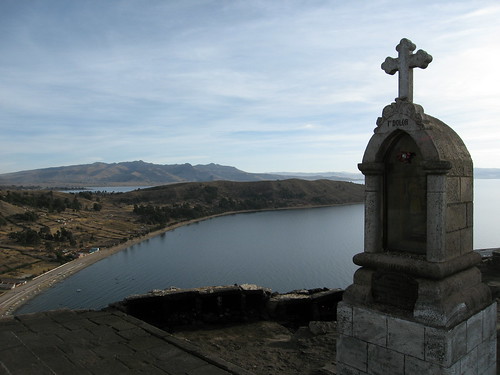
From our accommodations in La Paz we laboured up a long steep hill to the cemetery district to take a minivan to Copacabana it's a standard journey right up the point where you have to cross a lake. Passengers are encouraged to alight the minivan and take a passenger ferry across while the boat is driven onto a rickety wooden pontoon with an engine. Half an hour later all going well (the transport for the buses is seriously dodgy) bus and passengers make it across and the journey continues. Copacabana lies on the shores of Lake Titicaca, it's a touristy town, a place westerners come on their route through to La Paz and a place locals come to for pilgrimages. Good news for the town is it's full of excellent accommodation at very reasonable prices as well as lots of great restaurants.
We arrived and enthusiastically threw ourselves into the challenge of climbing the steep hill that overlooks the town. The Stations of the Cross mark the route to the top so it's an easy way to gauge how much effort you still have to make. The views down over Lake Titicaca and Copacabana are incredible. We made it up in time for a beautiful sunset. Later that night we ventured to the local market for dinner, we found a little old lady making up alpaca and potato skewers. They tasted exactly the same as Chinese skewers it was uncanny. One of the most outstanding elements of Copacabana were its sunsets. Every evening from the beach the most spectacular sunsets would be unveiled as the sun sunk below the fishing boats.
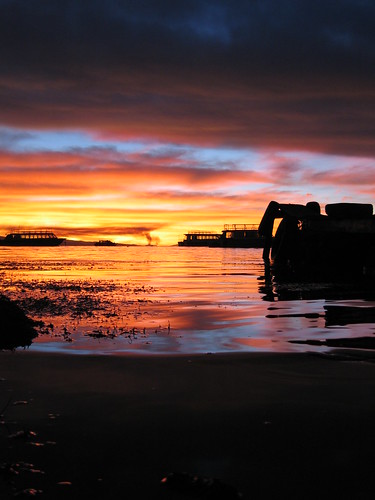
:: Stunning sunset over Lake Titicaca ::
Regretfully we opted for a day excursion to the Isla de Sol, as the legend goes it's the birthplace of the Inca civilisations. Nowadays the island seems to just try to cash in on tourists offering little in return. A manufactured trek i.e. a path from one end of the island has been constructed, you pay to enter the town in north, pay to walk along the path and then pay to come off the path and down the steps back to the boat. There's an obsession with tickets which detracts from the whole experience. A one off fee that would demonstrate a collective preservation of the island would be more ideal rather than constantly bugging visitors for more money and handing out ticket after ticket.

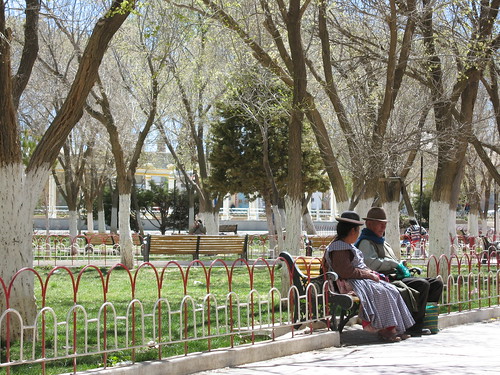
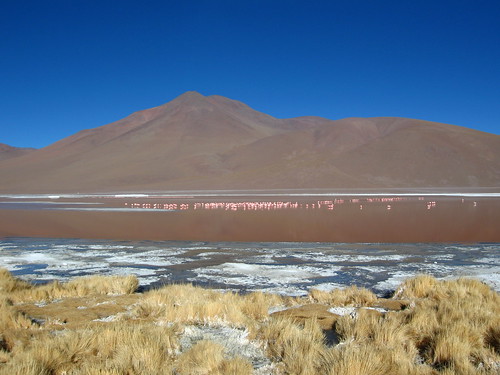
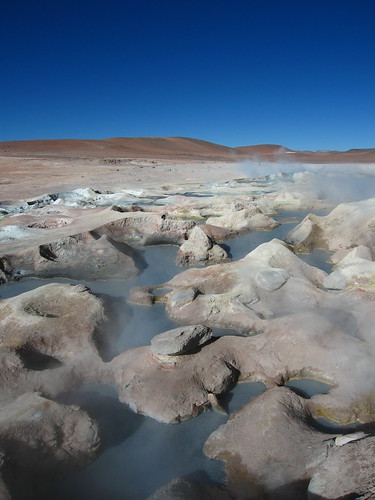
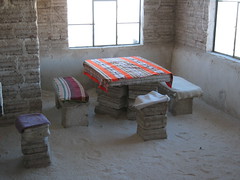


0 comments:
Post a Comment